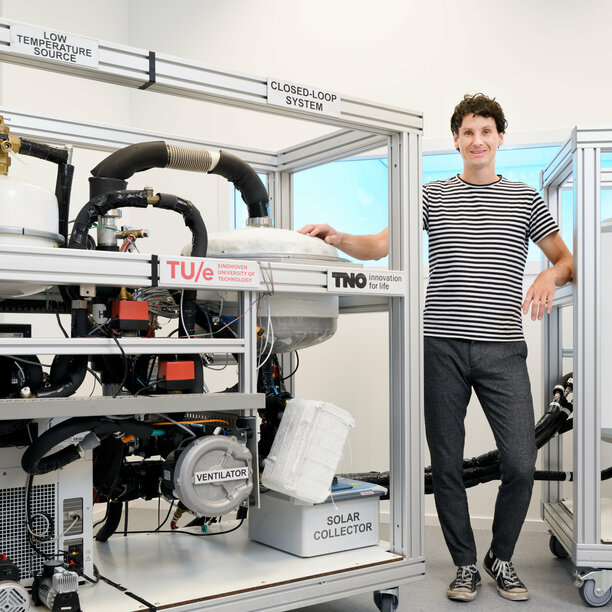Delivering when the heat is on
Whoever hears about Jelle Houben’s career in heat storage so far, might think it has all been carefully planned out. While in fact, where he is right now ultimately results from a decision that didn’t seem that important at the time. ‘After obtaining my Bachelor degree in Mechanical Engineering, I pursued an interdepartmental Master in Sustainable Energy Technology. As part of my program, I decided to take the course Transport in porous media at the Department of Applied Physics. During my oral exam for that course, I got talking to examiner Leo Pel about possibilities for traineeships. And that is how I ended up working on the heat battery at the Transport in Permeable Media (TPM) group for my Master’s end project.’
Battery worth his salt
At that time, his supervisors Pim Donkers, Henk Huinink and part-time professor Olaf Adan were working on the concept of a heat battery based on salt hydrates. The idea is simple: You take a chunk of salt and use the heat of the sun to evaporate all of the water out of it. When you subsequently need that heat, you only have to expose the salt to humid air to extract it again. ‘The beauty of our heat battery is that this storage is loss-free, even if you want to store the energy for weeks or months. That is a great advantage over most competitive heat storage concepts, like water beds, which gradually cool down. In that respect there is no direct competitor to our heat battery,' says Houben.
During his Master’s project, Houben explored different possible system designs. ‘At that moment, there were two major types of systems in use for salt hydrates,’ he explains. ‘Simply put: completely open, and completely closed systems. Both existing systems were not suitable for the built environment, they did not perform sufficient or were to complex and expensive. We merged the two in a new design which combines best of both worlds, and patented it.’ After years of extensive study, the group had also identified the most suitable salt to do the job: potassium carbonate (K2CO3). This salt has such a high energy density, that a refrigerator-size battery should be sufficient to supply a medium household with warm tap water for about two weeks. A demonstrator was built that proves the patented battery design works rather well with this salt. With a patent on the system design and a working material, the researchers decided to start a spin-off company, called Cellcius.
Dopants for fast charging
‘For the battery to be truly commercially viable, we now need to improve the charging and discharging speed,’ says Houben. ‘On a sunny day, you need to be able to fully charge the battery in a couple of hours, and it needs to release its heat fast enough to take a hot shower.’ That is where his PhD research comes in, again supervised by Henk Huinink and Olaf Adan and furthermore supported by Hartmut Fischer from TNO ‘I am introducing so-called dopants, small amounts of different atoms, into the crystal lattice of the salt to speed up the reaction’. He uses techniques from the Darcy lab and TPM’s other facilities to characterize the resulting crystals, and to understand their behavior. ‘We use for example X-ray diffraction techniques to study the crystal lattice, electron microscopy to pinpoint the exact location of the dopants, and gravimetric experiments to study the material properties at different pressures and temperatures.’
In the meantime, field tests are planned with the pure salt to push the technology toward higher Technology Readiness Levels. ‘We are working on a large-scale European project called HEAT-INSYDE. The goal of this project is to bring the heat battery closer to market introduction. In this project we will test our heat battery at people’s homes in three different European climate zones. It will be interesting to see how our system holds up under different circumstances, for example when a house is badly isolated or when the heat demand is high during cold winters.’
Heat on demand
Not only the heat battery, but also Houben himself is facing a bright future. ‘I am currently working on my final experiments, and will start writing my thesis soon. Soon, I will join our start-up Cellcius. I am convinced we are developing a battery that will become a key component in future energy systems, where it will enable households to use renewable energy anytime they want.’

